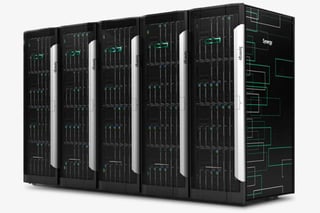 If your data center is on an evolutionary track from siloed and hardware-centric to agile and software-defined, you’re aware of converged and hyperconverged infrastructures. If you haven’t yet been introduced to composable infrastructure, welcome to the next gen step in your data center modernization journey.
If your data center is on an evolutionary track from siloed and hardware-centric to agile and software-defined, you’re aware of converged and hyperconverged infrastructures. If you haven’t yet been introduced to composable infrastructure, welcome to the next gen step in your data center modernization journey.
Hyperconverged combines compute and storage resources into a single workload-optimized appliance and added a software layer to the data center. Composable infrastructure takes it to the next level by disaggregating hardware so it can be provisioned for any workload at any time and then reprovisioned for future needs; and amplifies the software-defined flexibility, agility, stability, automation, efficiency and speed you’ve grown accustomed to. Plus many (many) more benefits.
Composable infrastructure begins here
The promise of composable is easy to see, however taking the next leap in data center modernization isn’t. A move to composable also doesn’t happen (successfully) without careful planning and a team. Before we look at benefits, consider these types of questions:
- What are your operational and financial goals?
- What problems are you trying to solve, a single and discrete or a systemic?
- How quickly do you need to deploy your applications?
- Does average server overprovisioning amount to more than 85%?
- What is your organization’s requirements for data security?
Benefits of composable infrastructure
The benefits of composable infrastructure are many and varied, but in short it has the ability to drive innovation, reduce costs, speed time to deploy applications, and ensure business demands can be met in real time. Here are a few more advantages:
- Continuous, streamlined IT delivery
- Updates are made without interrupting regular IT operations
- DevOps can automate applications and accelerate application development
- Infrastructure applications can be replenished in a matter of minutes
- Infrastructure flexibility - The network is dynamically configured, allowing more flexibility
- Single platform – The hybrid environment reduces overhead and increases overall efficiency
- Reduces operational effort – It offers polished operations enabled through software-specific modalities
- Automation for a more simplified system - allows a future-proof data center ready to scale
- Application speed – Automation is used for hardware configuration to service the applications that demand it
- Improved governance – Governance is set by the organization which ensures it’s aligned with and supports business goals
Composable combines compute, storage, and network into centralized compartments. It efficiently delivers resources, meets the demands of your business and saves time for your IT department. It’s not always easy or worth it to be an early adopter, but when it makes sense the payoff can be huge especially when the prize is cost reduction, efficiency, faster time to market, and marketplace differentiators...
These are just a handful of advantages that come with composable. Check out what HPE is currently doing in this new technology with its HPE Synergy. WEI's Chief Architect, Dave Fafel, talks about why this solution is needed for data center modernization, talks about the 5 components of the HPE Synergy platform, and he tells you what you really need to know about this new technology.
Ask WEI for a demo of HPE Synergy to better understand how this new solution can benefit your IT organization.











